“Harvest” was one of those paintings that initially began with disparate and vestigial roots. I did have a vague inspiration for some kind of Mothman-like figure, and a cloudy but persistent feeling of the arcane. Additionally, a puckish impulse to include the robot, Claptrap, from the Borderlands video game, gained approval within my premise.
These were the foreground, midground, and background subjects, as seen in my first work-in-progress snapshot:
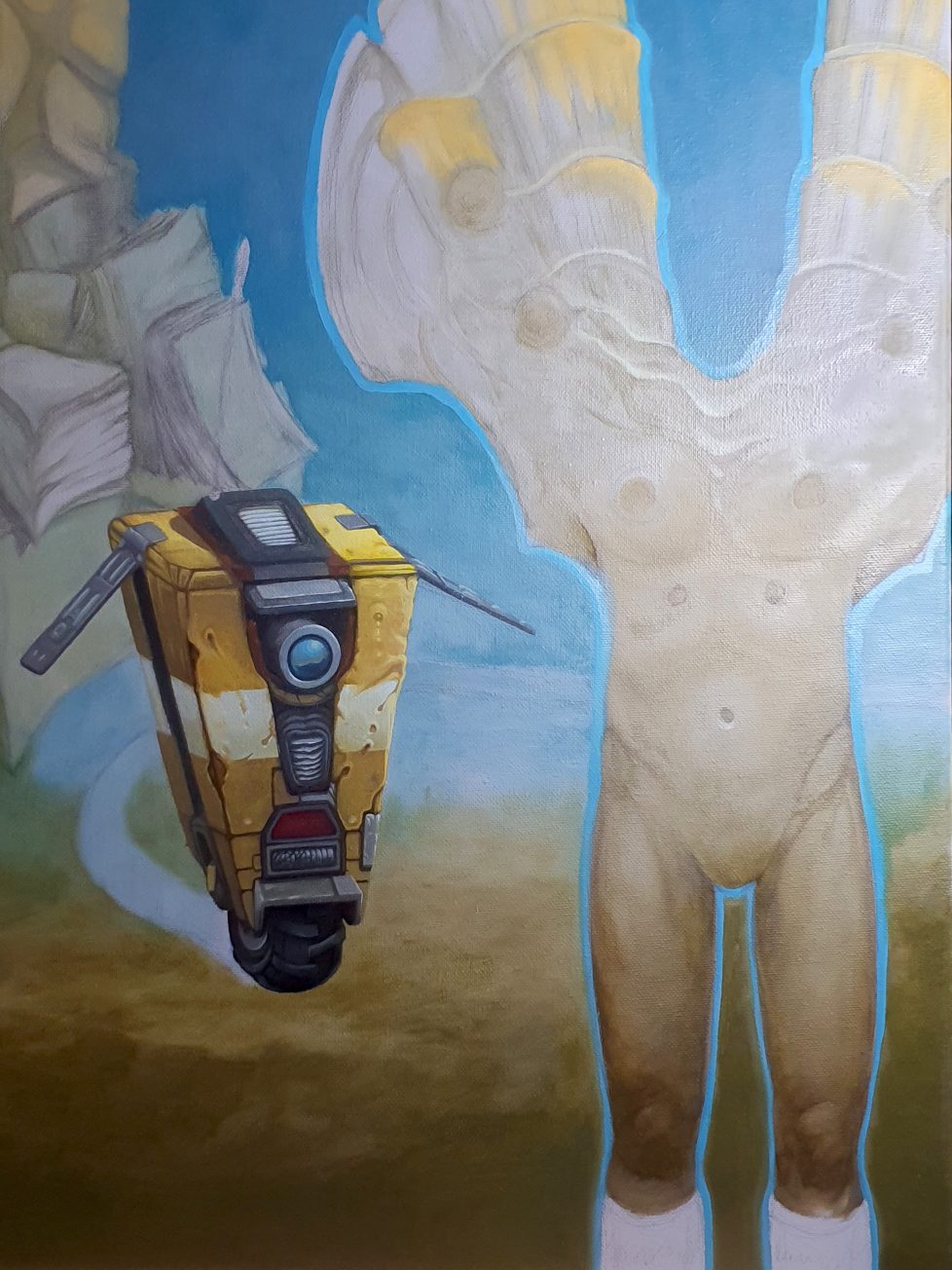
During the early stages of development, the Mothman figure began to gain muscle, and the Arcane Entity of the background gained a crescent lunar halo, which immediately reminded me of the ancient Sacred Bull symbols from antiquity. Its body was composed of what seemed to be pages, papers, or book-like forms.
The setting and the ontogeny of the figures were yet unrealized. How would the story unfold? How would they relate? It was still very much a mystery.
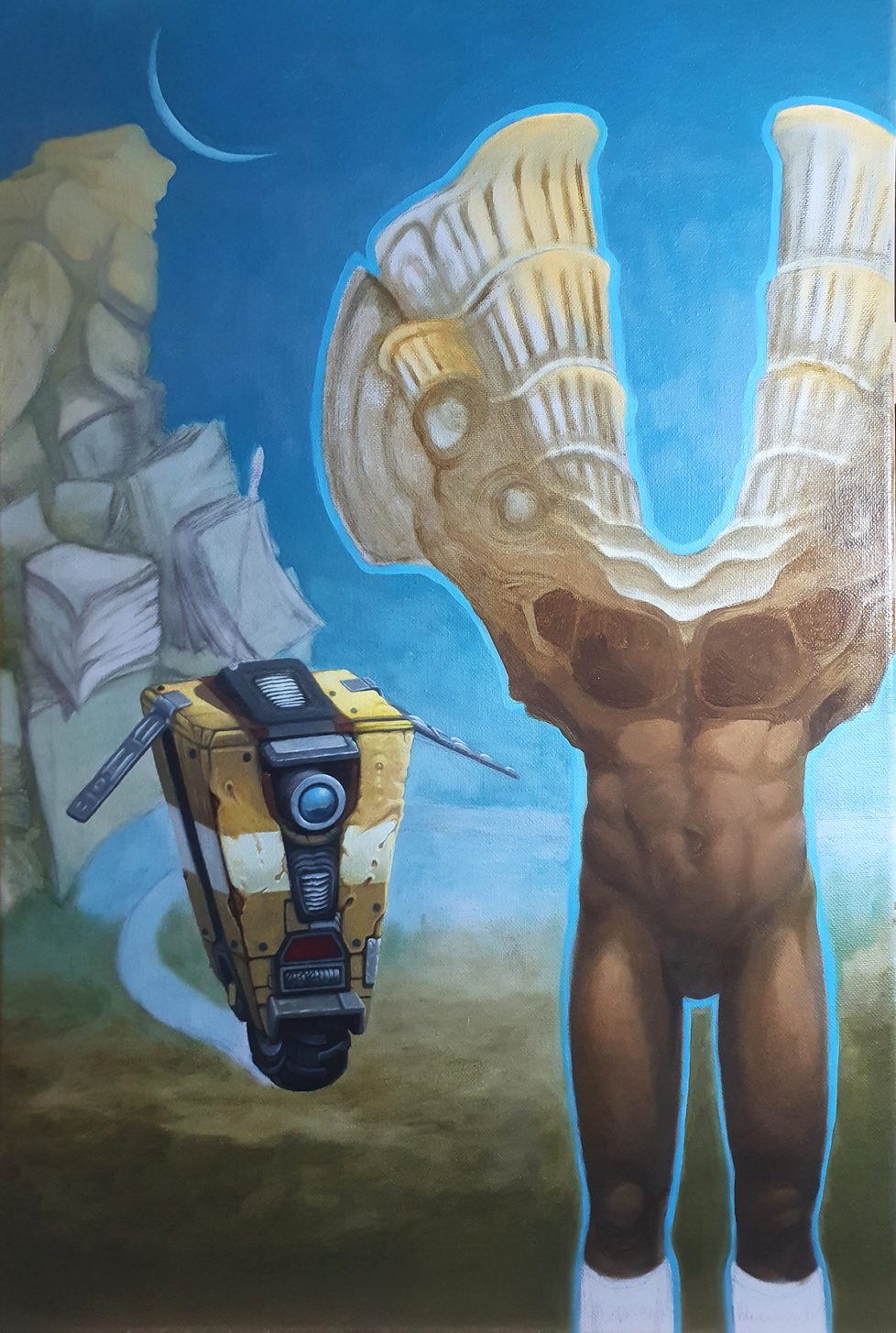
Mothman was the first to change radically, its chest region becoming prominent and further defined. Large new opaque eyes stared at the viewer. It also developed what appeared to be novel structures, a kind of open-air central sinus or sensory organ, from which small mantis-shrimp eye stalks emerged.
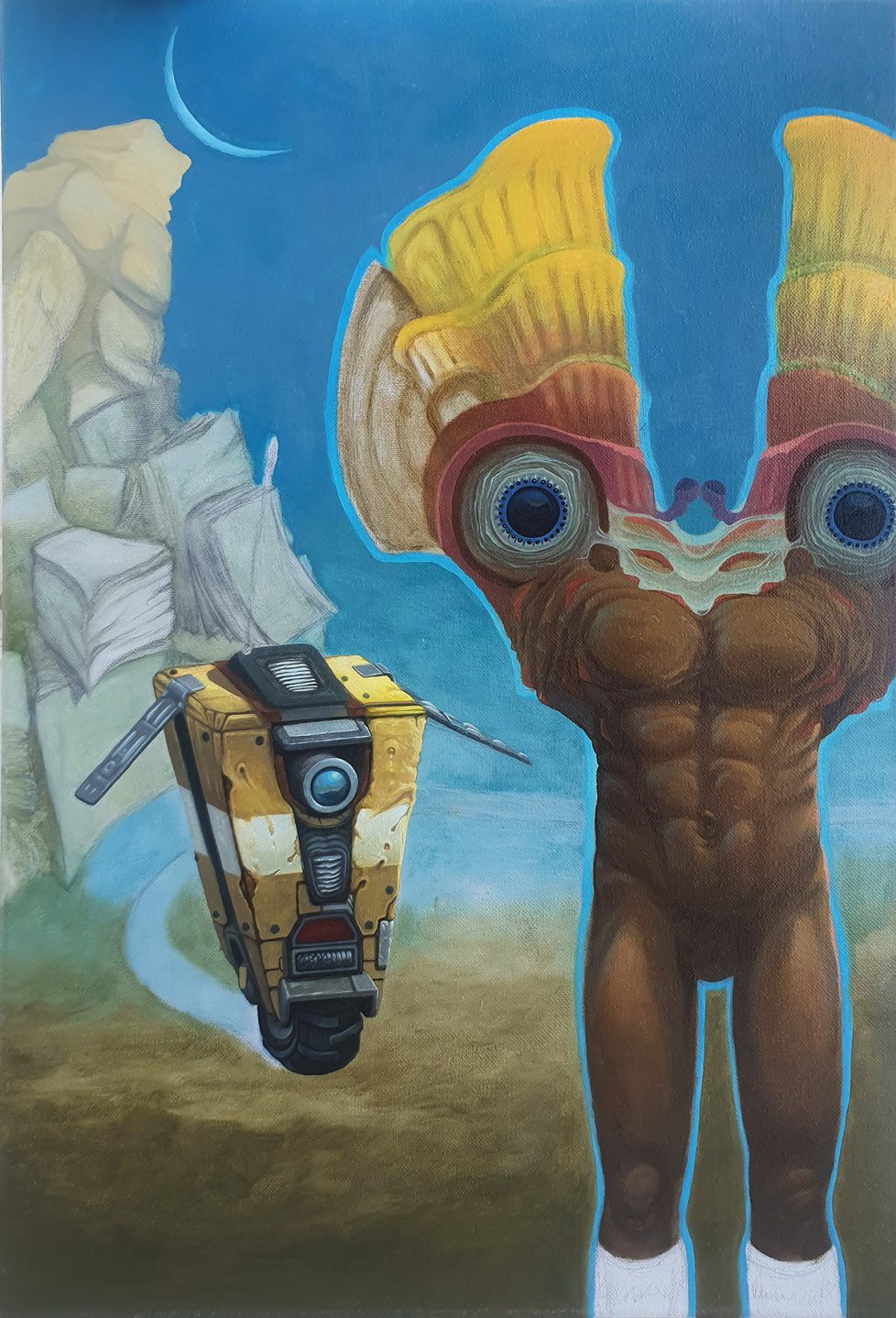
This transformation continued, particularly in the chest/face region of the figure as the central “sinus” began to develop concentric rings, and spill over, as seen below.
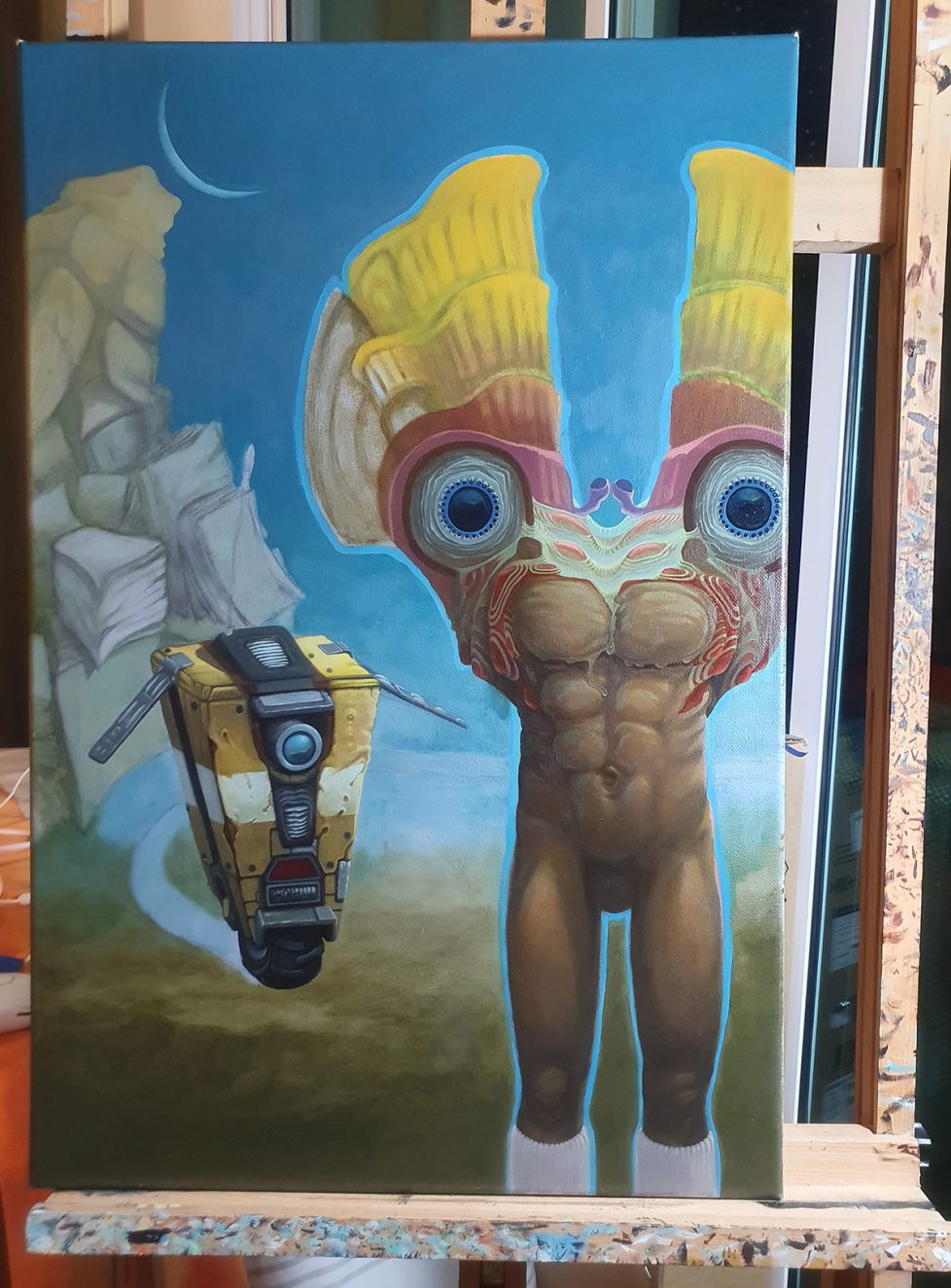
Ultimately, this lead to a cascade of mutations of Mothman’s upper form. It grew an ear, textured skin and teeth, and what appeared to be emerging feathers, all composing its head. The gap between its hemispherical structures became its space of mind.
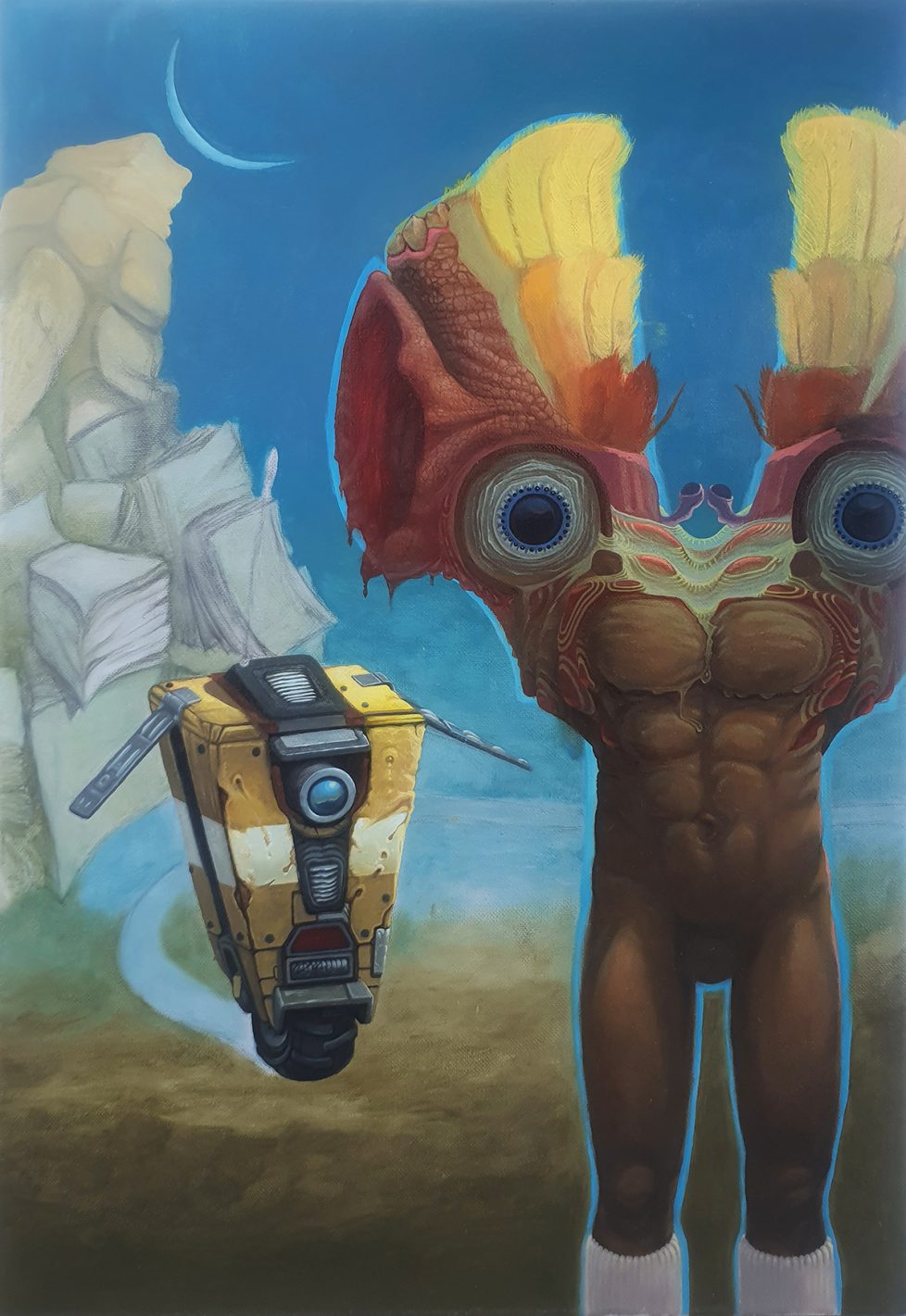
As if on cue, the Arcane Figure underwent its own reskinning. Its body resurfaced, and the book-like structures dissolved. For a brief interstitial period, the entity possessed webbed claws. Meanwhile, Claptrap attached some new arms, and began to busily attend a vat of bodies submerged within an open amniotic sac.
Quietly during this phase, a grey alien head also materialized behind one of Mothman’s legs.
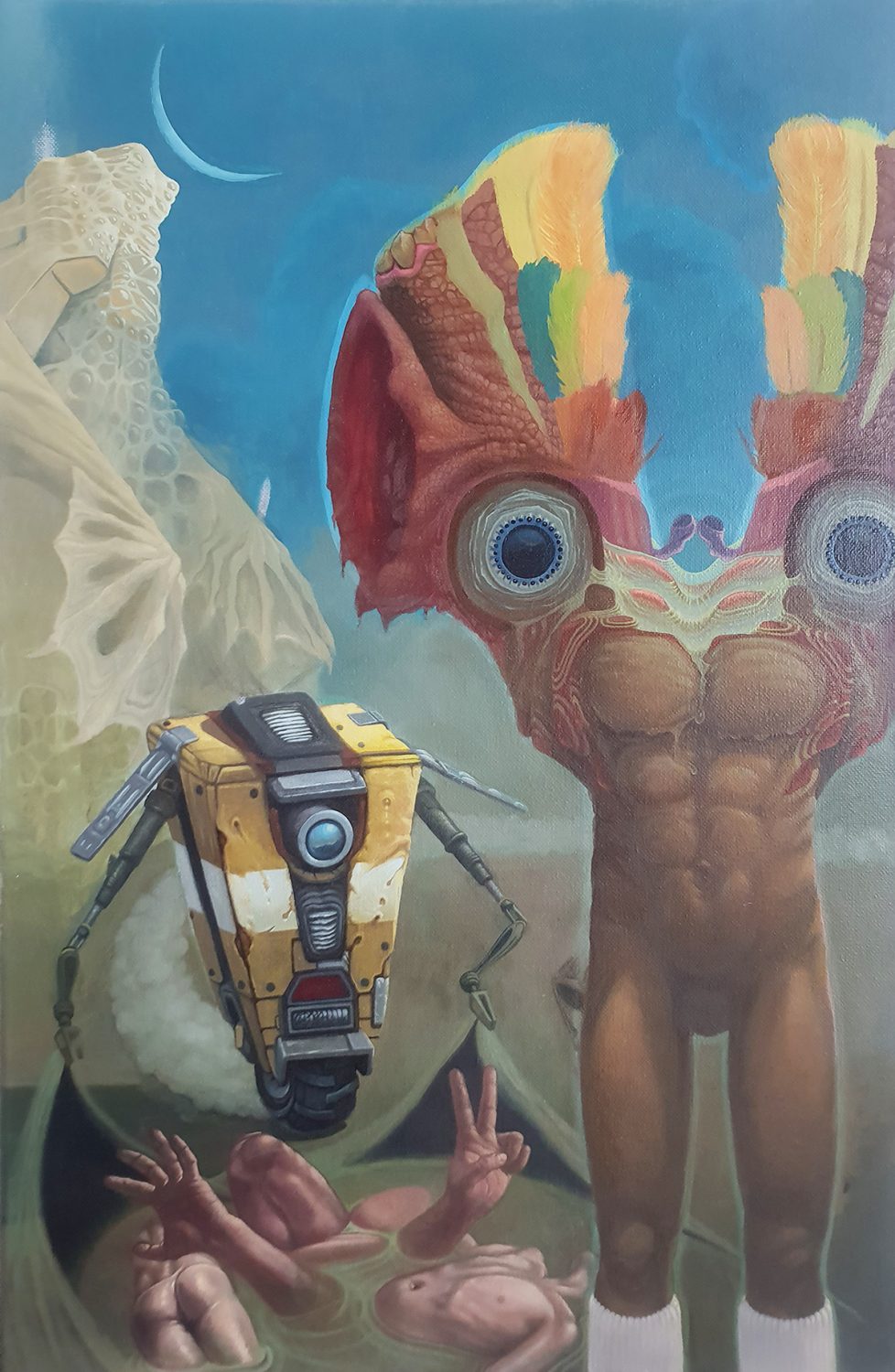
The Arcane Figure continued to mature, shedding its clawed hands, one of which was replaced by a rectilinear structure resembling a large hard-cover book. This development then inspired me to include an old Commodore floppy drive to its body. It felt more final and true to the spirit of the initial idea–the Arcane Figure being akin to a statue or a relic, possessing ancient knowledge or occult properties.
The entity related to old ways and primitive forms. It therefore also signified the archaic.
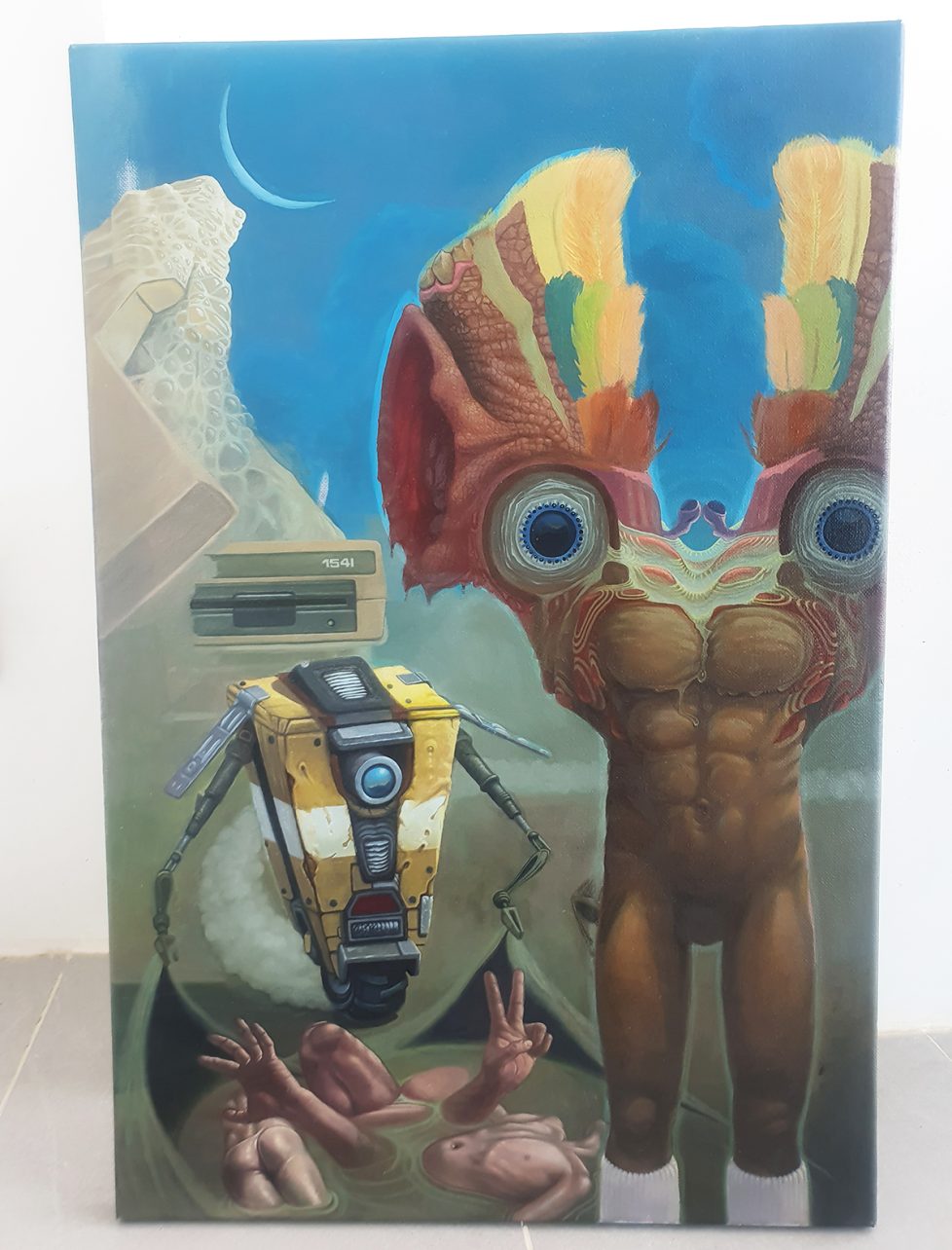
As the meditation on “old ways” continued, it devolved into a grimacing, drooling maw at the very base of the Archaic Being–teeth as a kind of fundamental human technology and institution.
The book is rendered to include a red bookmark ribbon, and proto cuneiform writing on its cover. The ribbon served to illustrate the book as an object, and balance the red-blue hues of the painting, while providing visual circulation from background to midground.
Black lines projected out from the Mothman, whose mind flowered radially along its scaffolding, terminating in a spire reminiscent of a Thai temple.
The vat of bodies also changed, its amniotic liquid shifted to a blue spectrum, to further balance the painting’s color composition, and to better differentiate the foreground and background.
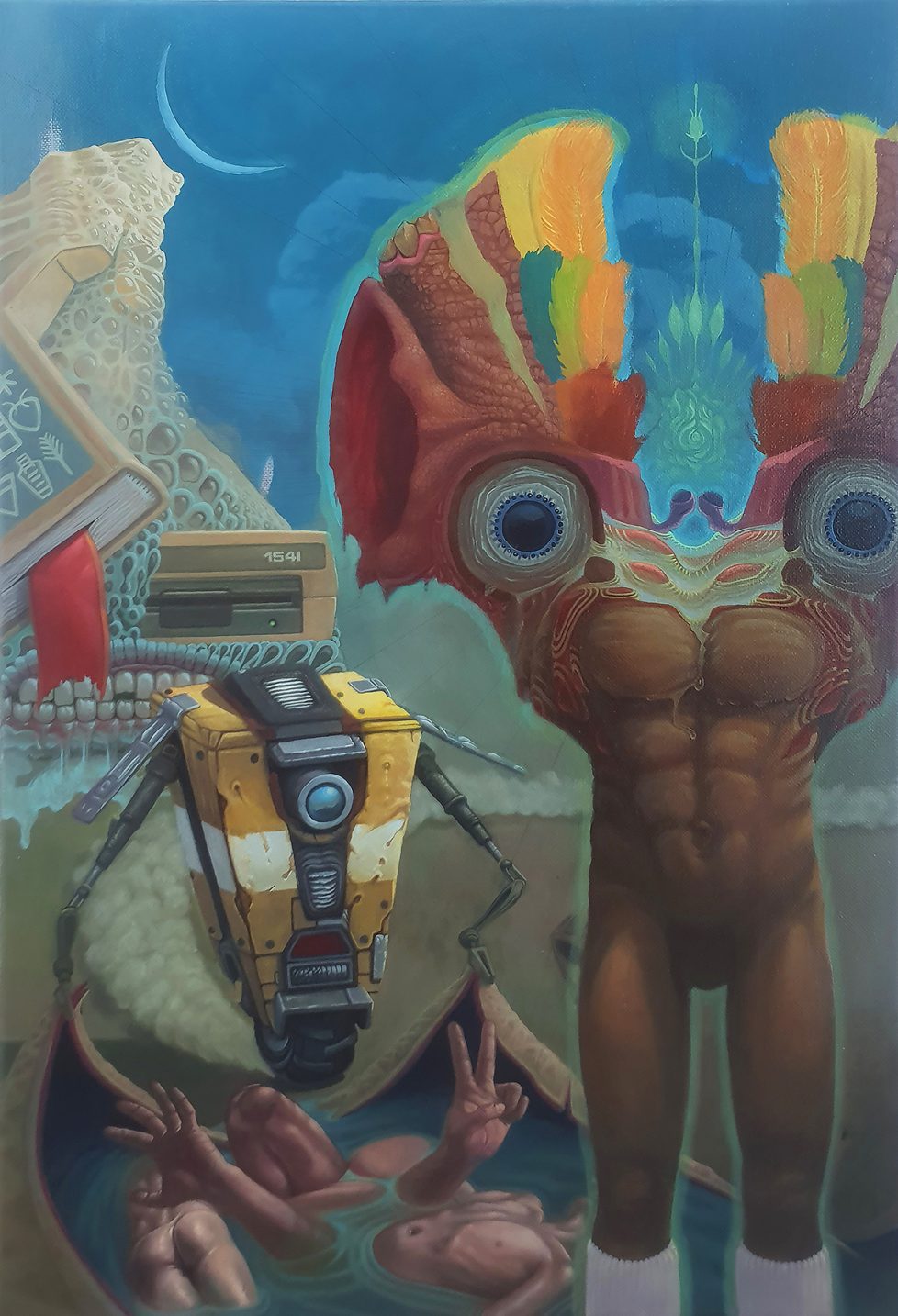
It was at this point the painting had firmly established all of its characters, and hardwired its compositional foundation. The grey alien head began to disappear, and all the actors in the scene could now evolve toward their final forms.
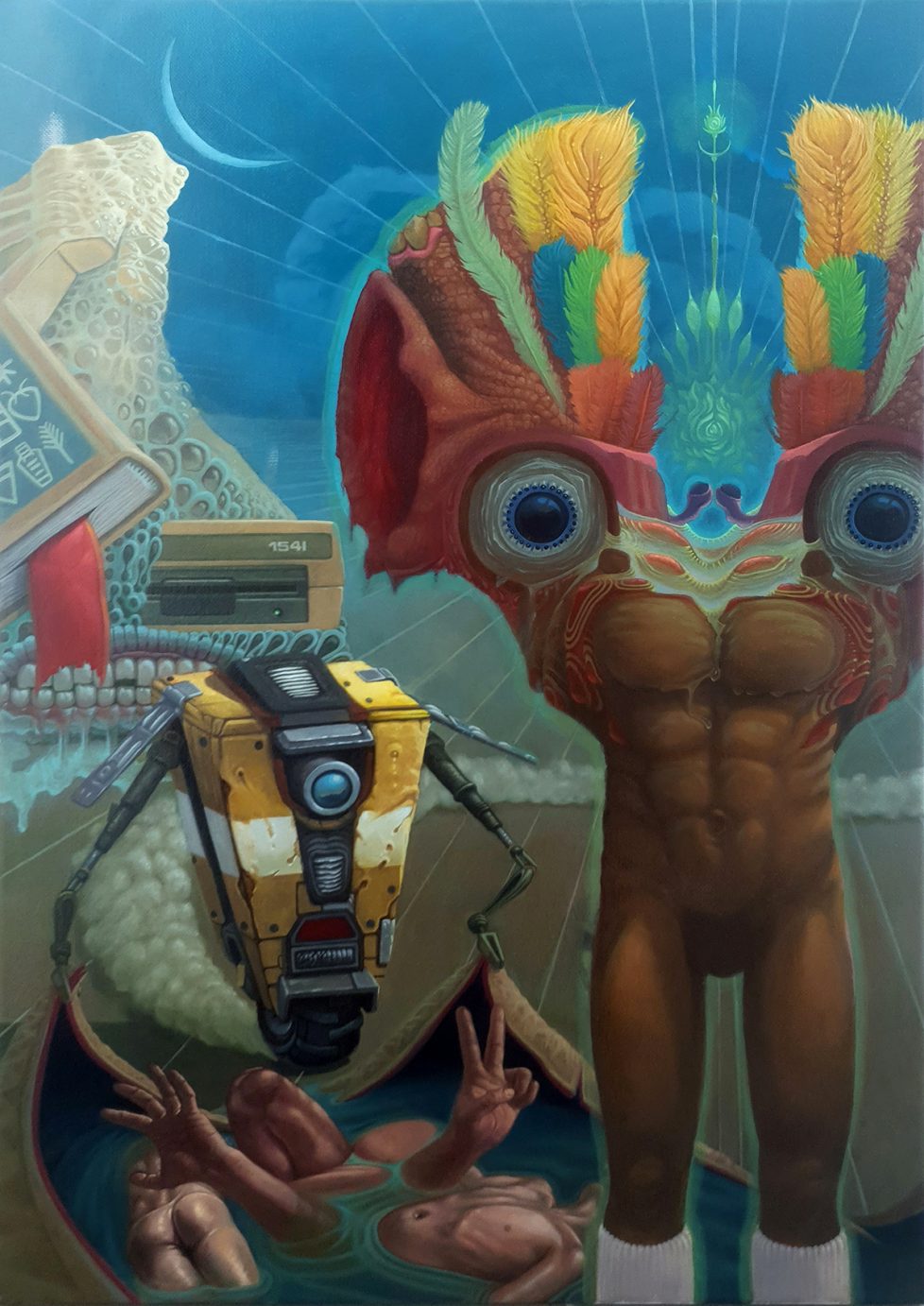
The last details of the image emerge. The Archaic entity’s body, composed of cells, actively released bubbles in the background. The rays cast from the central mind of the Mothman are finished, providing new perspectives above and below the horizon. Stars erupt against the dark sky, and the intrepid Claptrap gains a bandaged antenna and an “UwU” on his red display.
The entire painting was retouched to resolve each characters’ traits, like Mothman’s socks, the Commodore drive’s rainbow stripes, and the slimy flesh of the amniotic sac.
This resulted in the finished image, and it was at this stage that I could, at last, interpret the fundamental narrative, and find a name for the work.
Special Note:
This piece was also one of my first to be minted as a 1/1 blockchain rendition, and represents me as part of the Permanent Genesis Collection of the MOCA (Museum of Crypto Art).
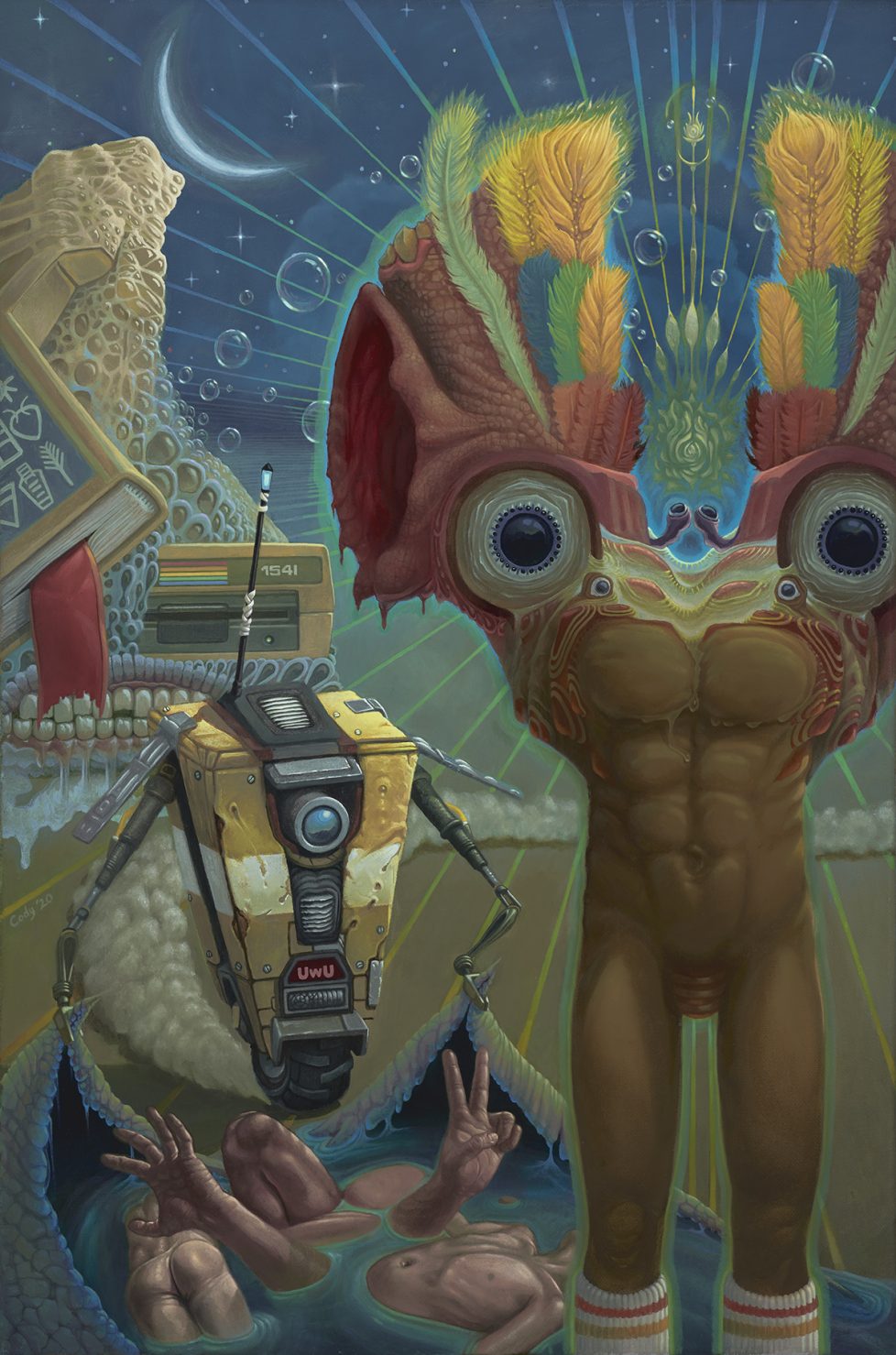
Official Description of the Oil Painting:
An anthropomorphic figure stands, wide eyed, staring at the viewer; its body masculine and muscular. Its “mind” dissociates into a conglomerate of structures resembling feathers, grain, teeth–as well as a radial flower “node”, casting linear rays throughout the composition.
To his left, a vat of bodies gesture and writhe in a kind of amniotic soup, attended by the robot Claptrap from the Borderlands video game franchise. Claptrap’s red display reads “uWu”.
Behind the robot and filling the left side of the composition is an archaic figure composed of a variety of vintage objects and symbols. Among them are a hardbound book with ancient cuneiform scripts, indicating barley, beer, bread, ox, house, and sky, behind which is a grimacing, salivating jagged toothed maw; and an old Commodore floppy drive. The figure’s head tilts toward an illuminated crescent moon, suggesting the Egyptian Sacred Bull.
The archaic figure is composed of a variety of mutating cells, which shift in color, and pattern; eventually breaking free into an ephemeral broadcast of bubbles which move across the background.
The work came into being against a psychological introspection, which included associations to pop culture such as alien abduction and pod people, as well as quite a bit of reflection on grains as a symbol of civilization, agriculture, sustenance, life, and imbibing (mainly whiskies).